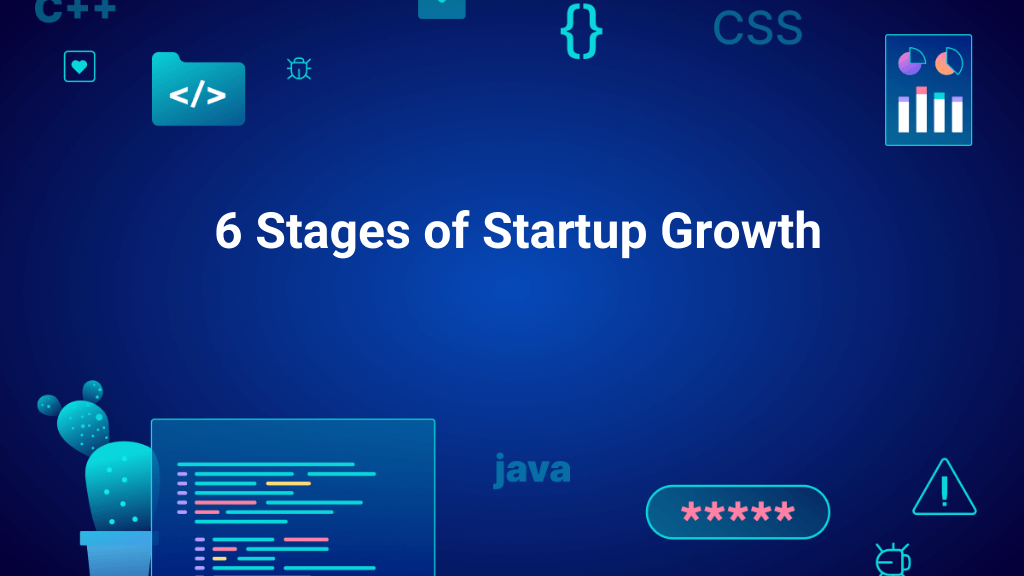Many aspiring entrepreneurs have dreamed of an idea that changes the world. But only a few take steps to form a startup company and make that idea real. Fewer still navigate the journey through the startup lifecycle and emerge triumphant on the other side. But to get to a destination, you need a map—and to be a successful startup, you need to pass through the six stages of startup growth.
Taking your idea from a dream to a viable business is no simple task. Launching a business seems easy, but 10% of startups don’t make it to the end of Year 1. Growing a startup to profitability can take 18 months to 4 years or more, depending on whom you ask. To make things more challenging, you must navigate significant growth stages along the way, and the trip might not be linear. However, none of this stops the approximately 305 million entrepreneurs who create startups every year—and it shouldn’t stop you.
To create a clear path, this post will break down the six stages of startup growth and provide tips to help your startup grow.
What is a successful startup lifecycle?
Before jumping into the growth stages, we must set up the bigger picture.
A startup is an entrepreneurship model that involves the evolution and growth of a new business idea. This business intends to occupy a specific market niche and serve end-user pain points. A startup aims to create a one-of-a-kind product or service, enter the market, and scale up quickly until it becomes indispensable to customers.
Startups are centered on rapid company growth through innovation and collaboration. To accomplish its objectives, a startup requires investments, feasible implementation strategies, and meticulous workflow techniques.
This journey is the startup lifecycle and comprises six growth stages—the steps required to create a new business for a particular customer segment. These stages of development occur between the time a product or service takes to acquire consumer acceptance and become popular in the marketplace.

A successful startup lifecycle starts with an idea and ends in a profitable, established business (or possibly a profitable sale of such a business). Profitability is a significant challenge, as only 40% of startups reach this goal. But for the startups that make it, the rewards are great.
VC vs. Bootstrapped: How Money Affects Growth Stages
Let’s not kid ourselves. While growing a startup into a big profit business is the goal, the fact is that how a startup is funded affects how a startup moves through its growth stages.
Bootstrapped companies may have the most challenges due to limited or uncertain funding, but they also have the most latitude. They are also the most common startups, with 33% of all small businesses beginning with less than $5000 on hand. As smaller, leaner organizations free of heavy investor oversight, a bootstrapped startup has more time to move between stages. They can even go back to previous stages if they find that they’re not ready to advance or it’s not working out.

- Venture capital (VC) investment companies generally receive over 1000 proposals per year and are primarily interested in businesses that require at least a $250,000 investment. They are interested in new companies with a considerable market, differentiating technology, and a team of incredible people. With significant funding in a larger company at stake, a VC-backed startup has pressure on it to move linearly through the growth stages. There’s no time to go back and forth, or stop and start.
For both financial models, moving forward into profitability is imperative because 44% of startups fail due to running out of cash. To help prevent this from happening to your startup, let’s walk through the six stages of startup growth.
The 6 Stages of Startup Growth
1. The Pre-Seed Stage
In this stage, you turn the idea for a new business into a legitimate business hypothesis. Your business idea needs to solve a specific problem for a particular group of people, and most importantly, it needs to be validated.
Analysis, market research, and feasibility studies must be done to ensure that your startup doesn’t become one of the 7% that fail because the market doesn’t need their product or service, or the 16% that fail from not having a business model.
This stage is about building the plan and foundation for your startup. To move forward, you should be able to answer questions such as:
- Is there a real problem that my solution addresses? Does my solution address a real problem?
- Who is my ideal customer?
- Are they using any similar products or services?
- How will my solution be different?
- Is my product or service similar to one already in the market?
- What features do customers want or need most?
Testing the demand and enthusiasm for your offering from its potential customers is critical. Once you have a workable plan, you can advance to the next stage.

2. The Seed Stage
In the Seed Stage, several things are happening at once to accelerate growth:
- You’re trying to build your product or service by developing prototypes. Multiple prototype iterations will be constructed, ultimately ending in your MVP (minimum viable product), which you can offer to a select group of people within your target audience.
- You’re continuing to validate your hypothesis and locking in the methodologies you’ll use to continue forward, conducting experiments and further analysis.
- In this stage, you’ll kick off fundraising, getting the financial “seed” required to begin building the business. Investments might come from the personal funds of founders, VCs, angel investors, incubators, government programs, and other sources.
Critical items to accomplish in this phase are building a great team to create your solution, finalizing your business plan, and securing enough funding to go to the next stage. The goal is to prove that your solution is worth investing significant funds in.
3. The Product/Market Fit Stage
At this stage, you’ve developed an MVP, and now it’s time to ship it to a select group of potential customers that personify your ideal customer profile. The goal is to determine if your product fits a need in the market.
After the MVP is released into the wild, gather and evaluate the feedback, make adjustments as needed, then repeat the process until the solution’s value proposition satisfies your target audience‘s need and solves their problem.
Customer retention is widely regarded as the gold standard for determining product-market fit, so be sure to question a large number of people if they would return to your product and recommend it to their friends and family.

Now is also the time to try new things in marketing, outreach, and financing and see what works and what doesn’t. Your company model relies heavily on trial and error in these early stages.
If you can prove that there’s a fit between the product and the market, and that people are interested, you’re ready to move on. This proof will also allow you to raise additional Series-A funding.
4. Growth Stage
Do you already have a product-market fit, and have you raised money based on having that product-market fit? If that’s the case, you’ve reached the Growth Stage. This stage is about demonstrating that you can scale your business—but be sure you’re ready.
How will you know? Besides reaching product-market fit, a good indicator is that when your marketing, outreach, and funding channels hit saturation, it’s time. Bring in experts and devote resources to expanding these areas. This will almost certainly entail seeking additional funding (Series B/C/D+), and you’ll probably be pitching to VCs by this time, even if you began as bootstrapped). You’ll also build your team and business culture and invest in external partners to assist.
The real work begins here, so remember that you don’t have to scale all channels at once; however, you may discover that scaling one channel depends on broader scaling throughout your organization. Measure everything and make data-driven decisions that power your company forward.
Unfortunately, this stage is usually where many startups get stuck because they can’t develop a sustainable and scalable growth engine. But if your startup has reached this point, there is demand for your solution, and that means you can expect increased profitability, more customers, and recurring customers as long as you create an engine that works.
5. The Exit Stage
For many founders, the next stage is to “get out while the getting is good” by selling the startup at peak growth and scaling. Very few startups arrive at this point, and those that do are distinguished by their strength, high potential, and opportunities for further development. Mergers and acquisitions are other options that appear at this point to founders with a shorter-term plan.
However, selling at the point you’ve established your startup as a viable business is far from mandatory. Many founders have long-term business plans. Taking your startup into a maturity stage where it continues to grow and prosper is incredibly rare and profitable, so much so that the final stage is named after a magical, fictional animal.

6. The Unicorn Stage
The ultimate dream of any founder is realized when their formerly scrappy startup becomes a bonafide juggernaut—a privately-held unicorn with a $1 billion+ valuation. At this point, everyone knows the name of your company. Think of Facebook, Uber, and ByteDance, all unicorns.
Your company has matured and continues to grow and expand into new areas while improving its core offerings. Founders may wish to take the company public and offer stock via an IPO. You’ve crossed the threshold and are a startup in name only, so congratulations! Perhaps a victory cigar is in order. Your only job now is to keep on growing.
Grow Your Startup with the Right Marketing
While the failure rate of startups is high, many persevere and grow through the startup lifecycle. Whether bootstrapped or backed by VCs, every startup must pass through the six growth stages. Most never make it to the last two stages, and that happens for many reasons. One of the most critical elements in any startup’s success story is marketing. Without effective startup marketing, your chances of going from Pre-Seed to Unicorn fall from slim to none.
At mvpGROW, our specialty is growth marketing for startups. Whether it’s content, lead generation, PPC, or social media, our full-service agency understands how to ensure your ideal customers know that your brand has the solution to their problems.
Book a call and get a free 30-minute consultation on any startup-related issue you choose. We’re ready to help founders remove their bootstraps and ride that unicorn into the sunset.

The Founder & Chief Getting Sh%T Done Officer of mvpGrow. After about 8 years as a hired hand some of the largest (and smallest) B2B SaaS companies worldwide I decided to hang up my employee slippers and lace up my growth agency cleats. But just because I’m an agency doesn’t mean we can’t chat (no charge). Please email me on any topic and I will gladly reply: eyal@mvpgrow.com

